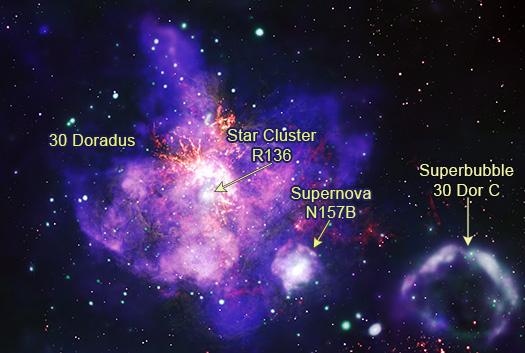A bouquet of thousands of stars in bloom has arrived. This composite image contains the deepest X-ray image ever made of the spectacular star forming region called 30 Doradus.
By combining X-ray data from NASA’s Chandra X-ray Observatory (blue and green) with optical data from NASA’s Hubble Space Telescope (yellow) and radio data from the Atacama Large Millimeter/submillimeter Array (orange), this stellar arrangement comes alive.

Otherwise known as the Tarantula Nebula, 30 Dor is located about 160,000 light-years away in a small neighboring galaxy to the Milky Way known as the Large Magellanic Cloud (LMC). Because it one of the brightest and populated star-forming regions to Earth, 30 Dor is a frequent target for scientists trying to learn more about how stars are born.
With enough fuel to have powered the manufacturing of stars for at least 25 million years, 30 Dor is the most powerful stellar nursery in the local group of galaxies that includes the Milky Way, the LMC, and the Andromeda galaxy.
The massive young stars in 30 Dor send cosmically strong winds out into space. Along with the matter and energy ejected by stars that have previously exploded, these winds have carved out an eye-catching display of arcs, pillars, and bubbles.
A dense cluster in the center of 30 Dor contains the most massive stars astronomers have ever found, each only about one to two million years old. (Our Sun is over a thousand times older with an age of about 5 billion years.)
This new image includes the data from a large Chandra program that involved about 23 days of observing time, greatly exceeding the 1.3 days of observing that Chandra previously conducted on 30 Dor. The 3,615 X-ray sources detected by Chandra include a mixture of massive stars, double-star systems, bright stars that are still in the process of forming, and much smaller clusters of young stars.
There is a large quantity of diffuse, hot gas seen in X-rays, arising from different sources including the winds of massive stars and from the gas expelled by supernova explosions. This data set will be the best available for the foreseeable future for studying diffuse X-ray emission in star-forming regions.
The long observing time devoted to this cluster allows astronomers the ability to search for changes in the 30 Dor’s massive stars. Several of these stars are members of double star systems and their movements can be traced by the changes in X-ray brightness.
A paper describing these results appears in the July 2024 issue of The Astrophysical Journal Supplement Series. NASA's Marshall Space Flight Center manages the Chandra program. The Smithsonian Astrophysical Observatory's Chandra X-ray Center controls science operations from Cambridge, Massachusetts, and flight operations from Burlington, Massachusetts.
This release features a highly detailed composite image of a star-forming region of space known as 30 Doradus, shaped like a bouquet, or a maple leaf.
30 Doradus is a powerful stellar nursery. In 23 days of observation, the Chandra X-ray telescope revealed thousands of distinct star systems. Chandra data also revealed a diffuse X-ray glow from winds blowing off giant stars, and X-ray gas expelled by exploding stars, or supernovas.
In this image, the X-ray wind and gas takes the shape of a massive purple and pink bouquet with an extended central flower, or perhaps a leaf from a maple tree. The hazy, mottled shape occupies much of the image, positioned just to our left of center, tilted slightly to our left. Inside the purple and pink gas and wind cloud are red and orange veins, and pockets of bright white light. The pockets of white light represent clusters of young stars. One cluster at the heart of 30 Doradus houses the most massive stars astronomers have ever found.
The hazy purple and pink bouquet is surrounded by glowing dots of green, white, orange, and red. A second mottled purple cloud shape, which resembles a ring of smoke, sits in our lower righthand corner.
|
||||||||||||||||||||||||||||||||

| Share This |
|

